Why Playwork?
Playwork is a dynamic part of the Original Learning process
As part of the Original Learning Approach I write and talk about three roles of the educator - teacher, facilitator and playworker. The latter focuses on play, not the child, but play, with the understanding that if the play is in flow for all the children, then all the children will be thriving.
Child-Centred - Play-Centred – What’s the Difference?
Child-Centred Approach
Main Focus - The individual and collective child, and their interests, needs, choices, opinions, and pace
View of the Child - Children are capable, with their own needs, skills, weaknesses, knowledges and strengths, and should participate in their own learning with the support of others.
Role of the Adult - Notices the child’s needs, supports their interests, provides choices, inspires learning
Planning - Emergent and flexible, based on individual children’s interests and/or needs
Environment - Adapted to suit children’s individual and collective needs and choices
Learning Mode - Can include play, conversation, project work, exploration, routines
Curriculum Drivers - The child’s opinions, identity, and agency
Example - A child obsessed with dinosaurs is supported to explore them through books, drawing, and conversation
Play-Centred Approach
Main Focus - Play itself as the natural and most effective mode of learning
View of the Child - Children thrive and learn best when able play enough - each child’s play enoughness is unique to them in combination with the play needs of the group.
Role of the Adult - Curates environments and opportunities for rich, meaningful play, and protects time and space for play to ensure play sufficiency for both the group and the individual.
Planning - Structured to ensure play is prioritised, protected, and integrated into daily routines, this does not compromise teaching and/or learning, but enhances it.
Environment - Designed to be play-rich, with open-ended materials, space for imagination, movement, social interaction etc
Learning Mode - Primarily through different types of play (symbolic, physical, imaginative, social)
Curriculum Drivers - The value of play as a developmental driver and space of thriving.
Example - A child obsessed with dinosaurs are given time and materials to freely build, pretend, move, explore — and adults protect this play with the same value given to learning
So What’s the Core Difference?
A child-centred approach puts the child at the heart of decision-making — learning might happen through structured or guided activities and play is not always given the same value or priority as teaching.
A play-centred approach believes that play is the primary and most natural way children evolve and thrive — and everything revolves around ensuring play opportunities are maximised. (this does not mean it is only play, but that play is sufficient for all children).
To summarise (remembering this is for educational settings):
All play-centred approaches are child-centred, but not all child-centred approaches are play-centred.
Child-centred is about who is at the centre of learning.
Play-centred is about how learning takes place.
From an Original Learning Approach perspective we will, as educators, be child-centred when we are teachers and facilitators, but play-centred as playworkers. I think there is great value in having multiple roles as educators and therefore more than one lens to view the child and the play.
I have adapted the playwork principles to work as play-responsive principles… (check the Playwork Foundation website for the original Playwork Principles)
All children and young people need to play. The impulse to play is innate. Play is a biological, psychological and social need, and is fundamental to the healthy development and well-being of individuals and communities.
Play is a process that is freely chosen, personally and collectively directed, and intrinsically motivated. That is, children and young people should not be compelled to constantly follow adult agendas. Play is the brain adapting to a complex world - it is learning, evolving, healing, discovering, exploring and more.
The prime focus of play responsive educators is to support and facilitate the play process through separate pedagogical activities, and play opportunities, and this should inform the development of play and pedagogical policy, strategy, training and education.
For play-responsive educators, the play process informs the teaching; and they act as advocates for play and learning autonomy when adult-led agendas dominate.
The role of the play responsive educators is to support all children and young people in the creation of a space in which they can achieve play and learning flow.
The play responsive educator’s response to children’s and young people’s playing/learning is based on a sound up to date knowledge of play/learning processes, and reflective practice.
Play responsive educators recognise their own impact on the play/learning space and also the impact of children’s and young people’s play/learning on them.
Play responsive educators choose an intervention style that enables children and young people to extend their play and learning. All play responsive intervention must balance risk (cognitive, physical, social, emotional) with the developmental benefit and well-being of all children, individually and as a group/class.
Together with Sion Edwards and Penny Wilson from The Playwork Foundation two years ago we played with the idea of a 9th Principle - which I have adapted as a play-responsive principle because sustainability, and social/climate justice are integral parts of the Original Learning Approach
Play-responsive educators support the development of a relationship between children and young people and the environment/more-than-human world. The Original Learning Approach exists within a balanced and sustainable play-ecosystem, rooted in social justice and inclusion. Play-responsive educators acknowledge the origins and fate of materials used, and consider how this may impact play equity and the wellbeing of future generations.
This 9th principle can be something that is taught in our teacher roles, scaffolded in our facilitator roles and as playworker it impacts the choices of materials offered, how we choose spaces with care to play in (because we don’t always only play in the pre/school yard or playground with children, we go on explorations and excursions) and how, when, if we intervene - not just from a perspective of safety of the children, but also safety of the environment when the more-than-human is of equal value.
Just as children have a right to scrapes and bruises as part of their play and way to learn through mistake making and risk-taking - so will the more-than-human experience scrapes and bruises as part of a play interaction. I think what is important is that we do not foster an exploitative norm to children, that they can do and take whatever they want; but neither should we be afraid of accidents that scratch and bruise the more-than-human if it is within a sustainable frame. And I think just like risk-taking is a personal thing, not only for those engaged in risky play, but also those observing it - the same is about this kind of natural damage - the same damage can be devastating in one place, but not in another - just as some observers will try to prevent all damage, while at the other end of the spectrum others don’t register any problem. We all need to find a balance that allows play and learning flow, is respectful of the more-than-human and can exist within a sense of reciprocity, including respect of local cultures beyond the normative culture of those at play and observing the play.
So what does the playworker role specifically offer in an Original Learning Approach setting?
Protects the integrity of play - Ensures play is not hijacked for learning outcomes. Play is honoured for its own value. Because we know that we are in the role of playworker, it becomes easier to protect the play because we don’t let the teacher role take over. This does take practice.
Practices presence and patience - Observes quietly, lets the child experience flow, intervenes only to support safety. Inclusion etc is dealt with in the teaching and facilitating roles. If we observe exclusion that is harmful in the moment we intervene, but otherwise we use our other roles to support a more inclusive space for play.
Creates play-rich environments - Curates spaces that provoke curiosity, risk, experimentation, and wonder — indoors and outdoors - not with a pedagogical focus but a play focus. How will the environments inspire and scaffold flow?
Listens without controlling - Trusts the child’s process, doesn’t step in with questions, praise, or corrections unless invited. If the play is in flow, we know the children are thriving.
Supports emotional resilience - Allows children to experience challenge, failure, conflict, and resolution within play.
Handles risk responsibly - Doesn’t eliminate risk — instead manages it to promote growth, confidence, and agency. At the same time the playworker role is watching for potential hazards and eliminating them.
Expands the adult’s perspective - Shifts adults away from needing to teach all the time, and toward trusting the child’s intrinsic learning power.
From an OLA perspective, the playworker role ensures that play remains a space of freedom, identity-building, and meaning-making — not just curriculum delivery in disguise.
Yesterday, when I was consulting about this at a preschool I also pointed out that the three roles are not fixed amount of time - eg 20 minutes teaching, 20 minutes facilitating, 20 minutes playworking (based on a 1 hour example) - sometimes it might be 5 minutes of teaching, 10 minutes of facilitating and 45 minutes of playwork. Sometimes, when the children arrive tired, grumpy and not in the mood - maybe that ends up being 5 minutes teaching, 10 minutes facilitation, 20 minutes playwork and 25 minutes of facilitation again because the children need support with their co-regulation. Sometimes the teaching is longer but shifts into a more participatory mode which is similar to scaffolding but is still more teacher supported.
There is no one way. It is a dynamic process where we utilise the three roles to create spaces of learning and play autonomy and flow. What i think is important is to reflect on how much time we spend in each role, and why that was necessary, to ensure we are not slipping into the more familiar roles of teaching and facilitating, but that we are giving time to the playwork.
When a group of children can collectively enter a state of flow (not all the same play flow, but all in flow) I have noticed that their ability to learn when I am in my teacher role is extremely effective and that I can slip into facilitator role. This flow happens when children feel seen, heard, safe and brave. The feel a sense of belonging. They know that both adults and children will listen to them and respect them. They experience joy together, we laugh, sing and can be silly together because no-one is afraid of what others think. There is a lot of work that goes into scaffolding children’s play flow in the education system - because the system forces so many children in the same space when their social-emotional and communication skills are still budding and not yet in full bloom. Children are negotiating all of this while at the same time trying to access their own play needs.
This is why I am in favour of preschools and schools training in playwork theory. This is why I am currently training two cohorts of playaristas - so that they can create a play-strategy for their workplace that allows them to shine a light on play and how valuable it is, as play (not a tool), for children’s mental, physical, cognitive, social and emotional health.
(but if you get me talking about pedagogy - then I will place the world at the centre - because the world is constantly changing. And play is the way the brain adapts to an ever changing world - throughout our entire lives)
The below photos are from Örebro in Sweden where the local commune has been working hard to make spaces playable from an understanding of play and not the usual assumptions about children and what they need. I think this subtle difference in thinking - play-centred rather than child-centred has resulted in some amazing spaces, including this forested area with small elements to inspire and sustain and expand play possibilities there.


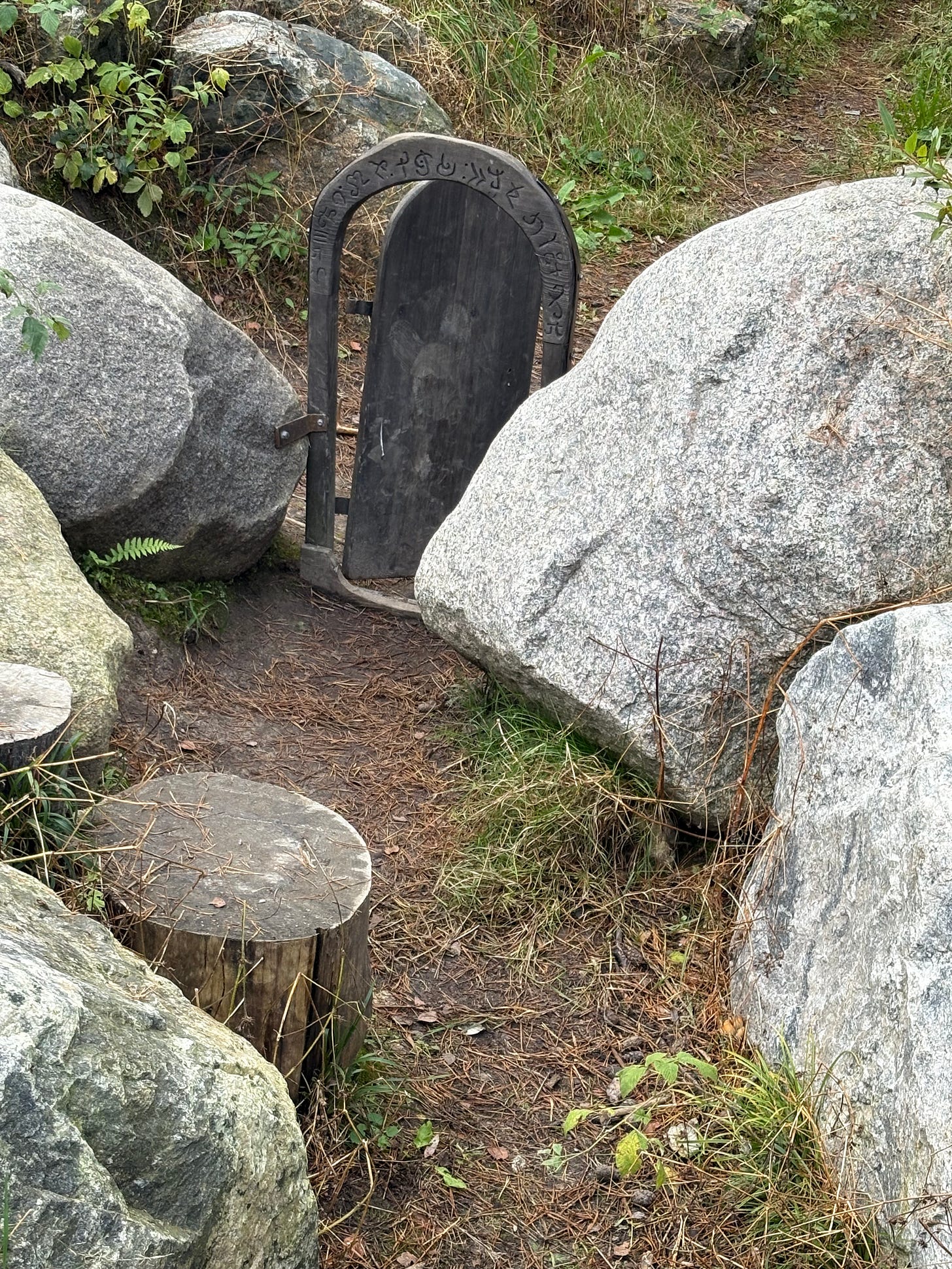
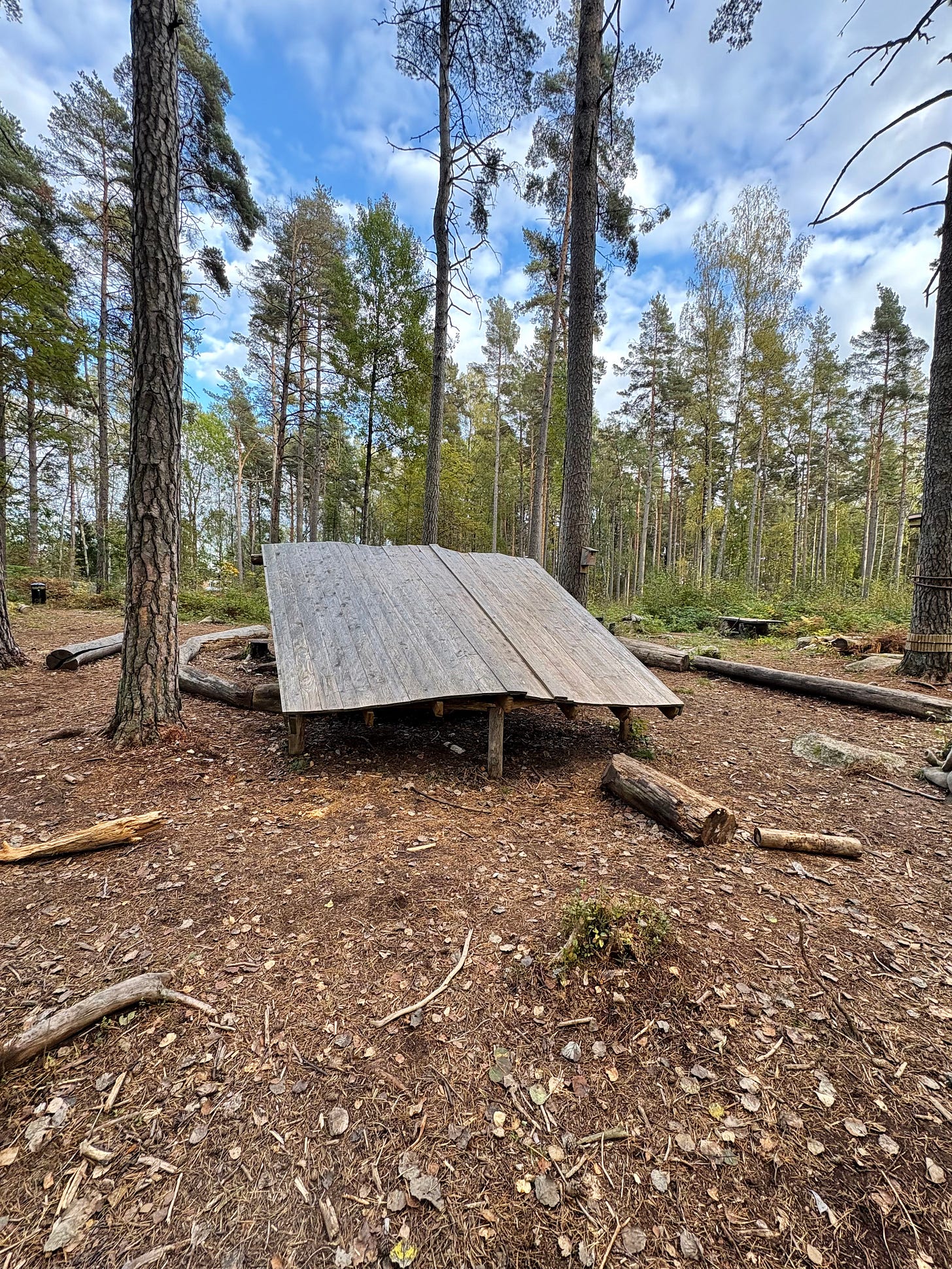
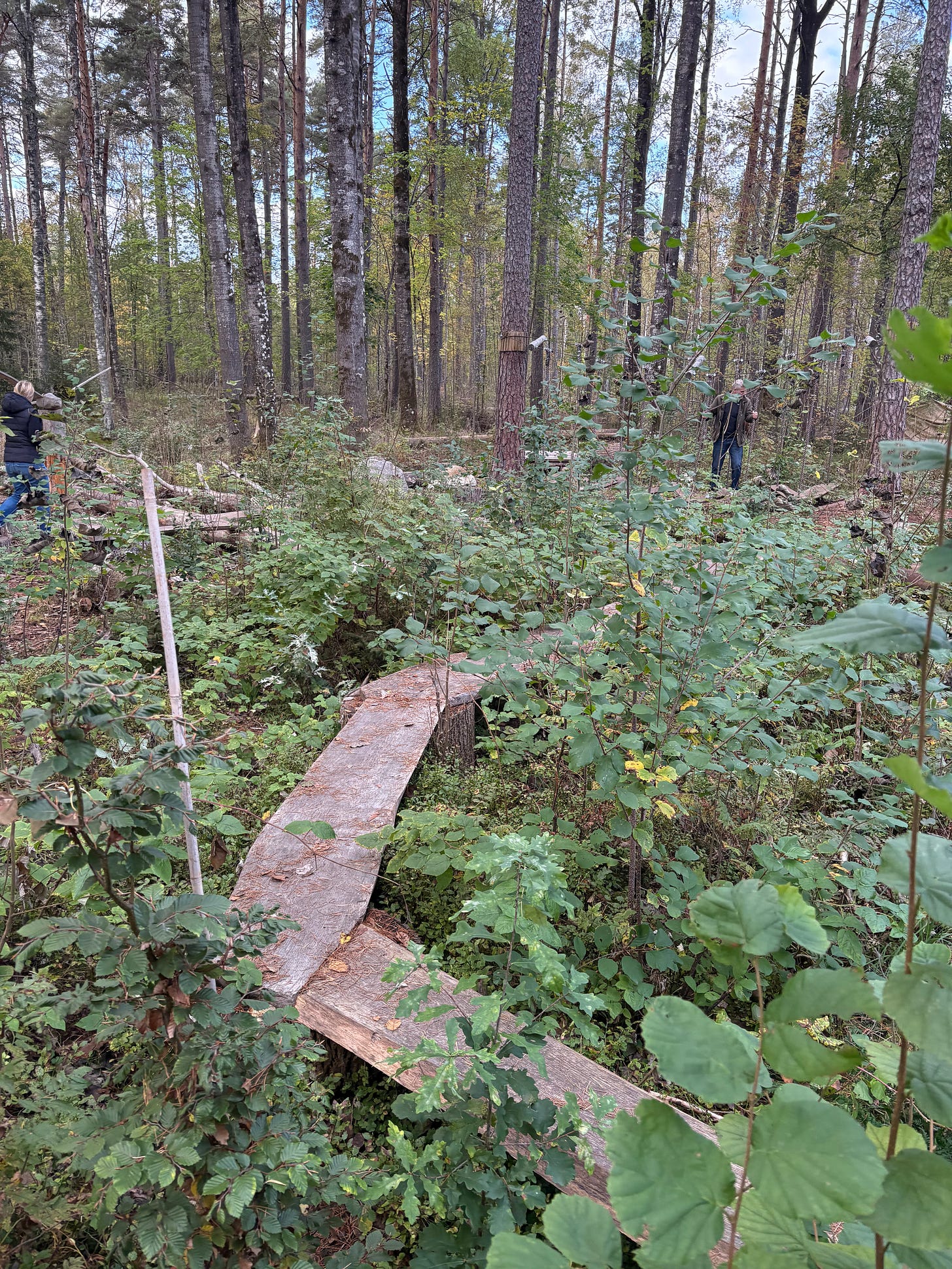
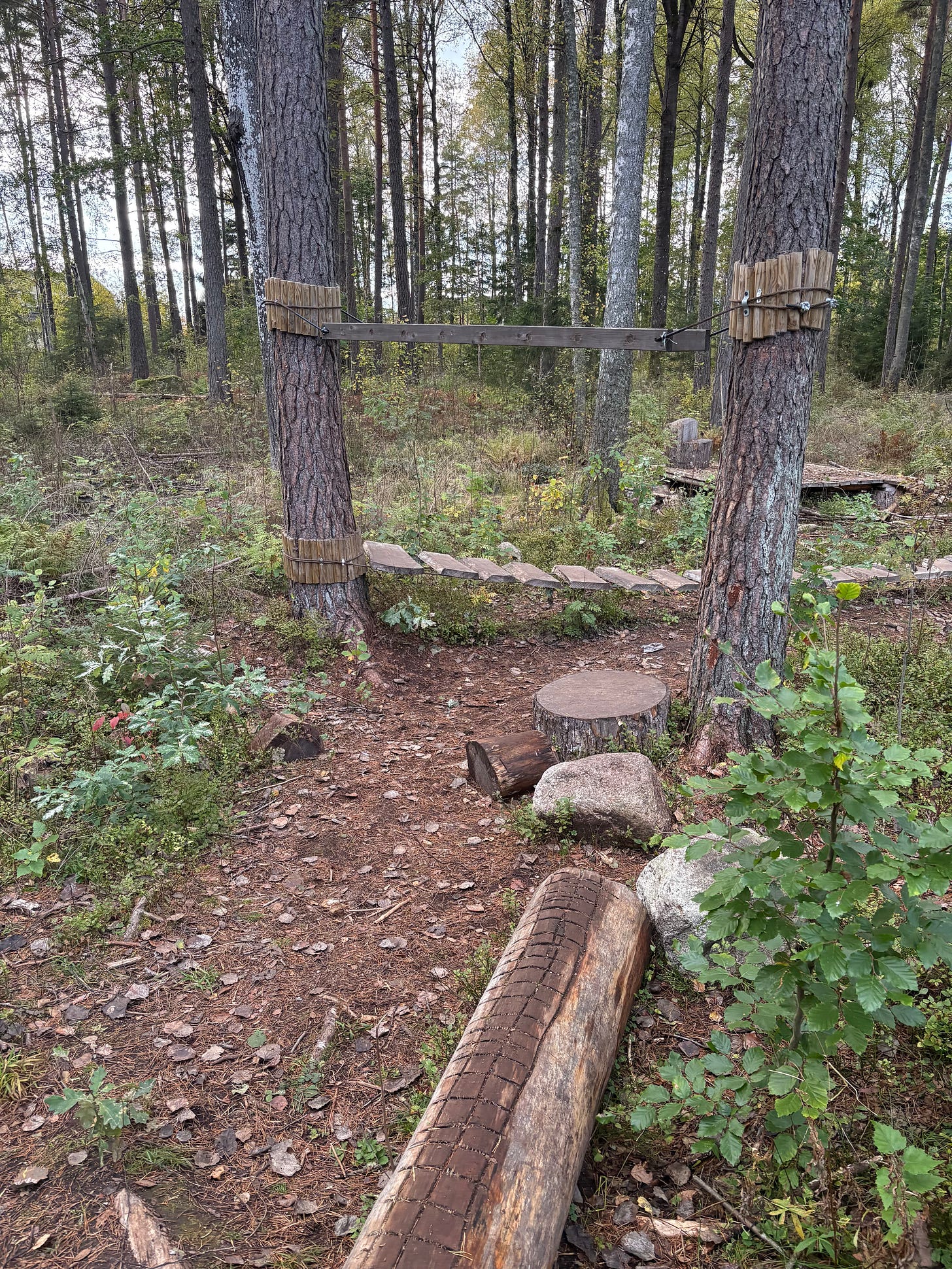

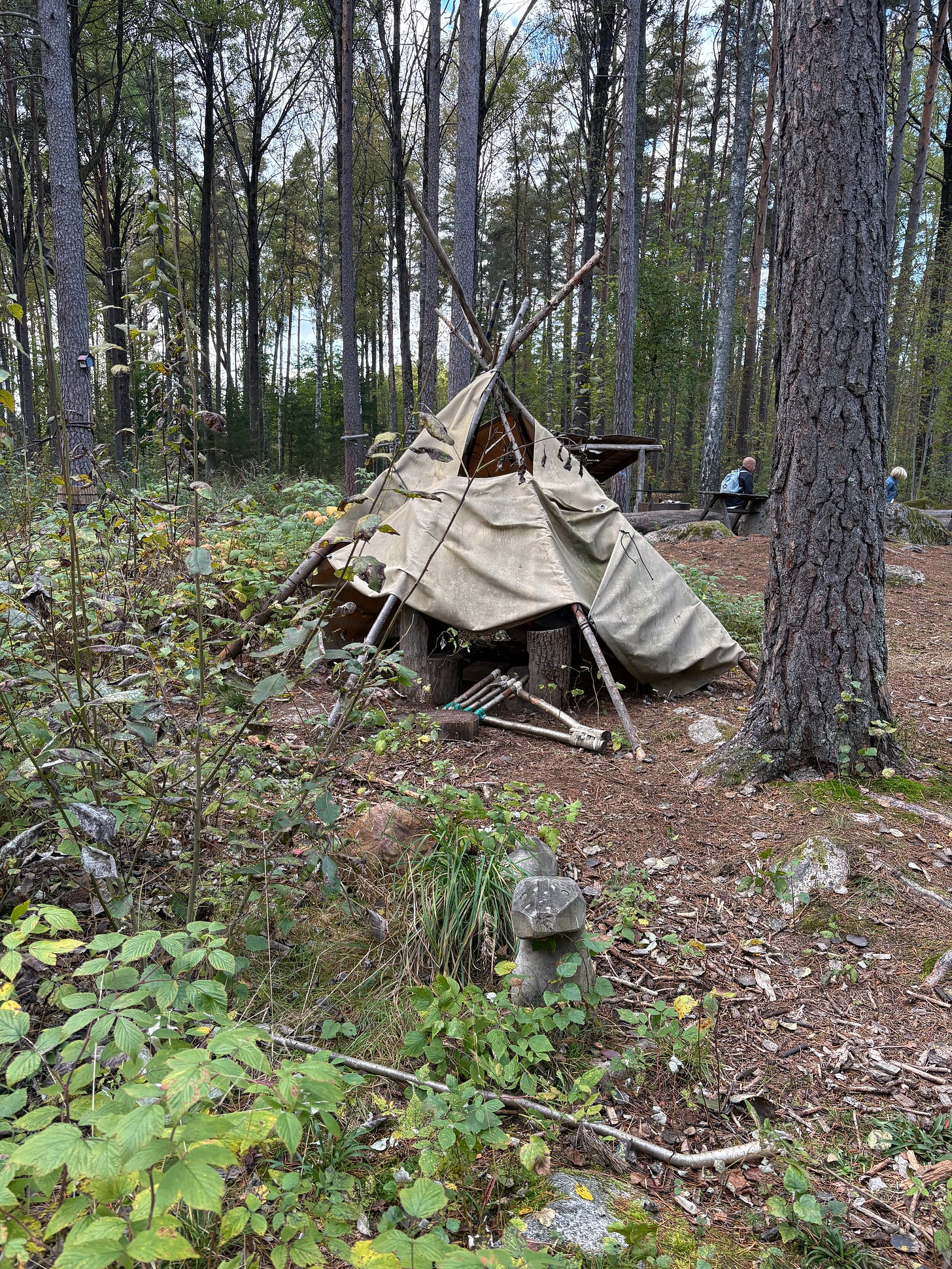
Thank you for clarifying the difference between child-centered and play centered. I love the boldness of the statement, "play is the primary and most natural way children evolve and thrive — and everything revolves around ensuring play opportunities are maximised."